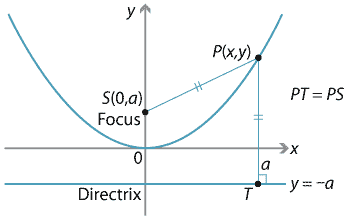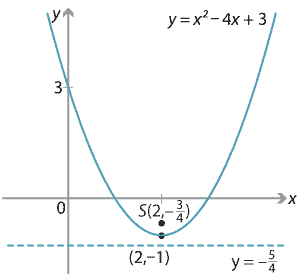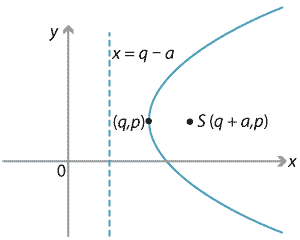Focus-directrix definition of the parabola
The Greeks defined the parabola using the notion of a locus. A locus is a set of points satisfying a given condition. These points will generally lie on some curve. For example, the circle with centre \(O\) and radius \(r\) is the locus of a point \(P\) moving so that its distance from the point \(O\) is always equal to \(r\).

Detailed description of diagram
The locus definition of the parabola is only slightly more complicated. It is very important and gives us a new way of viewing the parabola. One of the many applications of this is the refection principle, which we will look at in a later section.
We fix a point in the plane, which we will call the focus, and we fix a line (not through the focus), which we will call the directrix. It is easiest to take the directrix parallel to the \(x\)-axis and choose the origin so that it is equidistant from the focus and directrix. Thus, we will take the focus at \(S(0,a)\) and the directrix with equation \(y=-a\), where \(a > 0\). This is as shown in the following diagram.

Detailed description of diagram
We now look at the locus of a point moving so that its distance from the focus is equal to its perpendicular distance to the directrix. Let \(P(x,y)\) be a point on the locus. Our aim is to find the equation governing the coordinates \(x\) and \(y\) of \(P\).

Detailed description of diagram
The distance \(PS\) is equal to \(\sqrt{x^2 + (y-a)^2}\), and we can see from the diagram that the perpendicular distance \(PT\) of \(P\) to the directrix is simply \(y+a\).
Since \(PS=PT\), we can square each length and equate, giving
\[ x^2+(y-a)^2 = (y+a)^2 \ \implies \ x^2=4ay. \]The last equation may also be written as
\[ y= \dfrac{x^2}{4a} \]and so we see that it is the equation of a parabola with vertex at the origin.
The positive number \(a\) is called the focal length of the parabola.
Any parabola of the form \(y=Ax^2+Bx+C\) can be put into the standard form
\[ (x-p)^2 = \pm 4a(y-q), \]with \(a > 0\), where \((p,q)\) is the vertex and \(a\) is the focal length. When a parabola is in this standard form, we can easily read off its vertex, focus and directrix.
Example
Find the vertex, focal length, focus and directrix for the parabola \(y=x^2-4x+3\).
Solution
We complete the square and rearrange as follows:
\begin{align*} y = x^2-4x+3 \ &\implies \ y=(x-2)^2-1 \\ \ &\implies \ (x-2)^2= 4\times \dfrac{1}{4}(y+1). \end{align*}Hence the vertex is \((2,-1)\) and the focal length is \(\dfrac{1}{4}\).
The focus is then \((2, -\dfrac{3}{4})\) and the equation of the directrix is \(y=-\dfrac{5}{4}\).
A parabola may also have its directrix parallel to the \(y\)-axis and then the standard form is \((y-p)^2 = \pm 4a(x-q)\), with \(a > 0\).


